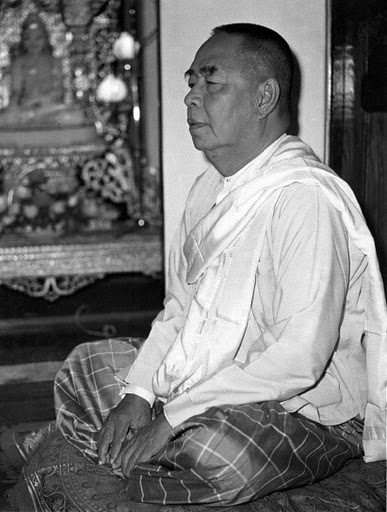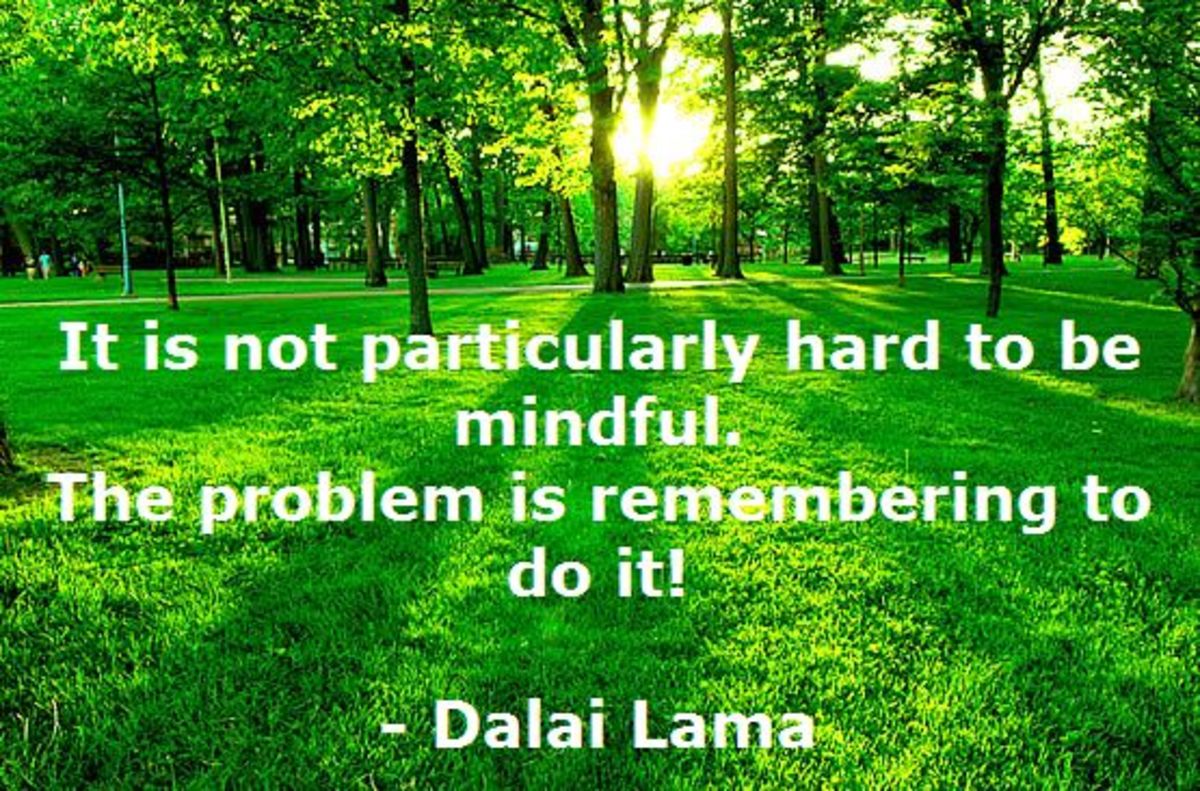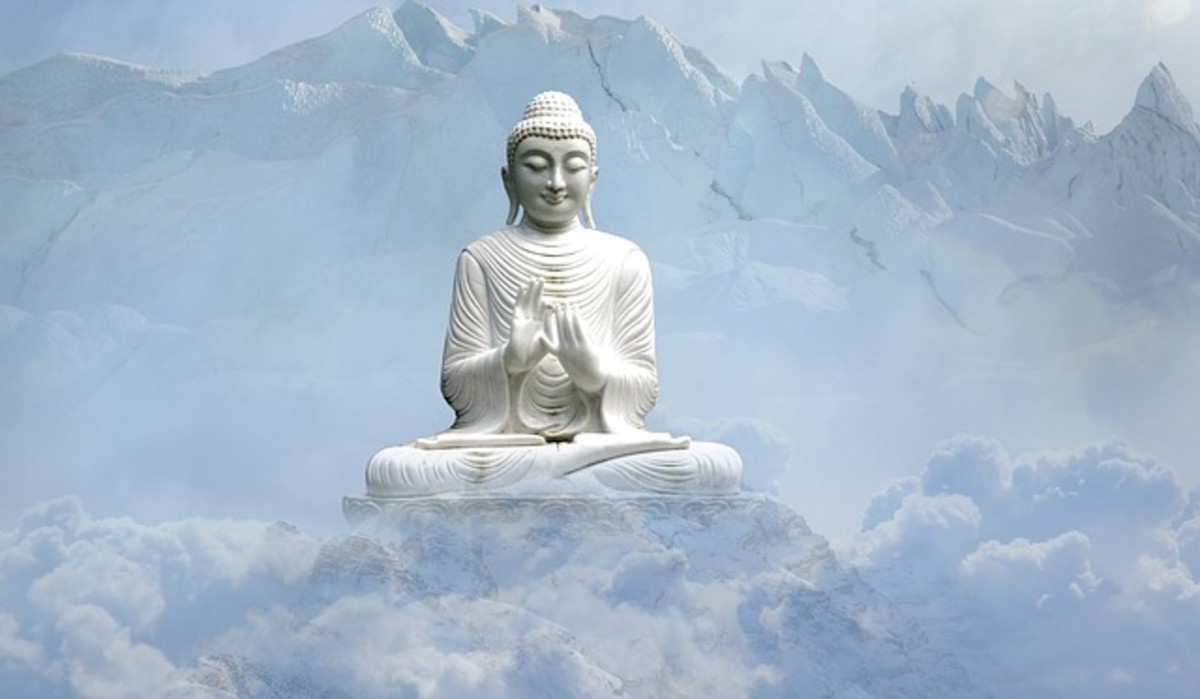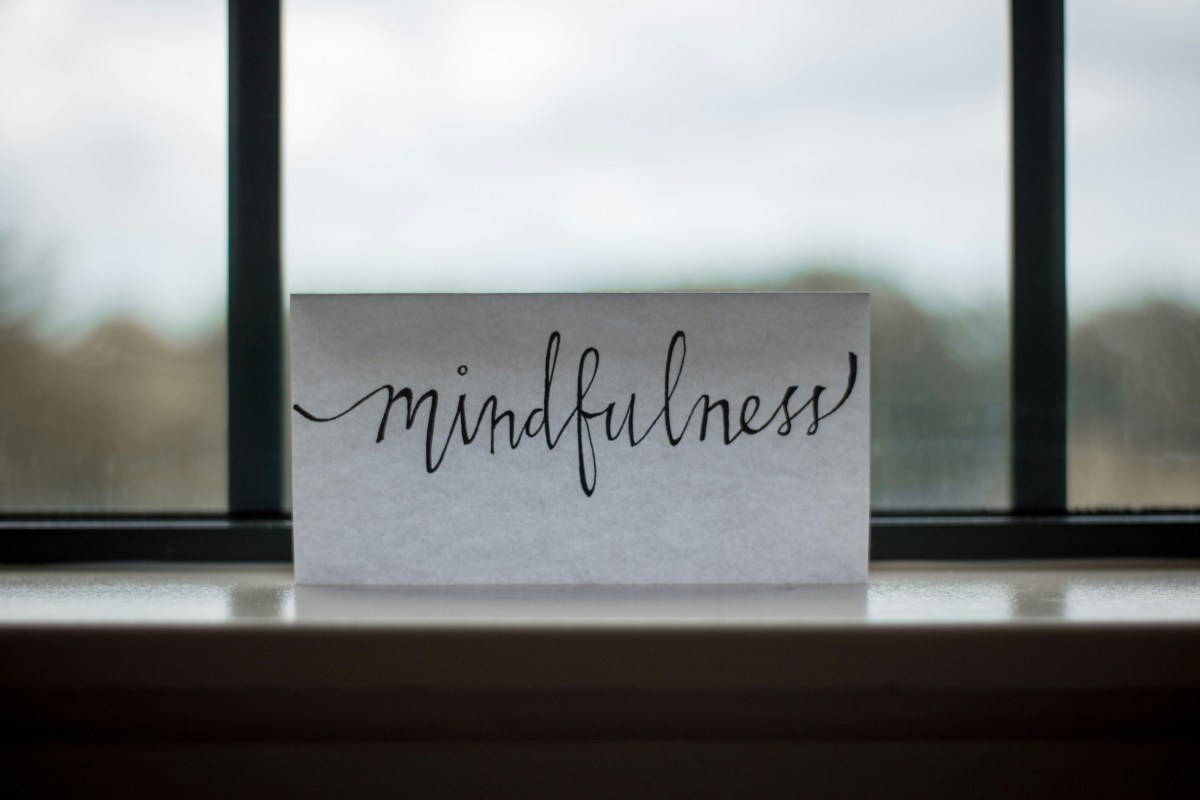4 Basic Ways of Mindfulness

The Nature of Human Mind
Human mind has the deeply ingrained habit of jumping from one to another sense objects of the 5 physical sense doors: eyes, nose, ears, skin, and tongue as well as the thoughts and emotions of the mind. There is no rhythm or system - the mind constantly moves from object to object randomly, mostly based on liking and disliking. No matter how hard we try we can't bring it in control. This is a basic problem of human existence that has been accepted as 'normal'.
This mind and people with such a mind are considered 'normal' in society. They can follow social laws and live within limits of social behavior. Only those who have problem leading a 'normal' life are considered mad. Psychiatry is the subject that focuses on such people and devices ways to 'cure' such people. But even if cured their minds remain feeble and wavering like others around.
However when it comes to meditation and evolution to higher mental plains of living a steady and firm mind is a must; a flickering mind is totally useless - because it is an undisciplined and 'feeble' mind. In order to eliminate its unsteady nature and make bring some firmness in it the practice of mindfulness is a wonderful tool.
Most meditators try concentrating their mind on some given object and end up wrestling with it which leads to considerable mental struggle. When mindfulness is adopted the 'tussle' gives way to acceptance and ease and the progress becomes smooth. Mindfulness means appreciating and respecting how the mind 'naturally' functions and tackling it in an insightful way. But what confuses most people is what exactly one should be mindful about. It is quite easy to get lost into ideation and lose touch with reality, if one tries to practice on one's own without proper guidance.
The most authentic and comprehensive understanding of the concept of mindfulness comes from the Satipatthana sutta (lit. the discourse on establishing firmly in mindfulness) of lord Buddha, given 2500 years ago. It still is the Gita or practical handbook for serious meditators of insight style of meditation throughout the world.
The Satipatthana Sutta
For meditators walking on the path of self-purification through personal efforts, the most important satipatthana discourse was given by the Buddha; he also called it the ekayano maggo - the only path for for termination of suffering, overcoming sorrow and purification of beings leading liberation. This liberation is nothing but getting rid of all roots of mental defilements we have all accumulated over the endless wondering in the world.
In order to explore the reality of ourselves, we must examine the realities of the body-mind complex (that is what we are!), ie, the body and its contents and the mind and its contents. These offer the four ways of establishing awareness about ourselves. We need to learn to observe them directly within ourselves. This observation is possible only through direct personal experience of physical sensations (vedana) that are always arising (and passing away) within the physical framework of the body, not through imagination or contemplation on some textbook philosophy of who we are.
Since the body and mind are so closely related that the actual experience of the mind or its content is also possible by observing the physical sensations because whatever arises in the mind is accompanied by physical sensations too. Therefore, observation of real sensations offers the important means of observing the totality of ourselves, mind and body both. The satipatthana sutta presents a practical method for developing personal insight by four-fold practice of kayanupassana (observation of the body), vedananupassana ( observation of physical sensations), cittanupassana (observation of the mind) and dhammanupassana (observation of the contents of the mind).
In ancient days, even before the Buddha, spiritual practitioners knew that craving for sense objects causes suffering. Thus, they indulged in various forms of penance and extreme abstinence from outside stimuli. However, the Buddha offered a totally different approach. He discovered that craving, in reality, arises for sensations produced by the outside stimuli. He also offered the right way to observe the sensations in the satipatthana sutta. This is an important discovery, because if we try exploring the truth merely through imagination and intellectual analysis we move away from the sensations (which reflect the reality of the moment). This keeps the practitioner roaming endlessly within the realm of mental content; in fact, he/she can imagine or think anything he/she wants to believe or has been led to believe! Such practices do offer some amount of peace and tranquility but leave the stock of mental defilements intact; therefore, no liberation from defilements. The Buddha showed that experiencing sensations is the only way to taste the reality, untainted by intellectual ideation.

Experience of Impermanence
We all know that nothing can last forever. No one who is born with remain alive eternally - death is a reality (if even if try hardest to remain oblivious towards it!). Geologists tell that what are mountains today had remained under water at some distant past. The time span might vary but the change is taking place eternally in everything.
Coming to the present topic the satipatthana sutta lays down the practical ways to experience impermanence by observation of arising and passing away of sensations. The practical training is of the sutta is called vipassana meditation (or insight meditation, because it develops insight about the reality within).
Looking at the title satipatthana some people tend to conclude that since sati points to awareness or alertness the discourse is merely about developing alertness (attentiveness). But what is the purpose of this mindfulness? In fact, it is not mere mindfulness (alertness) but the mindfulness directed towards experiencing the phenomenon of impermanence by directly observing the arising and passing away of sensations (called sampajanna in Buddha's Pali language). Advanced practitioner of vipassana (insight) meditation know that awareness has to be directed towards realizing impermanence - the core of Buddha's teaching.
4 Foundations of Mindfulness
For serious meditators this discourse offers the most valuable guidance because it clearly lays down the path of progress that ultimately leads to full liberation (from even all traces of defilements). The sutta begins with the observation of body through several starting points like observing respiration, paying attention to bodily movements, etc and then progressively develop awareness of the sensations, mind and its contents. Regardless of where one starts the path ultimately leads to realizing arising and passing (sampajanna) of all phenomena which is the goal of the practice of satipatthana. The meditator tries to stay with the experience of sampajanna as continuously as possible.
(1) Mindfulness of Body: One can observe the body in different ways. Observing natural respiration is perhaps the most practiced way to develop mindfulness of the body. It means constantly looking at or keeping continuous awareness of the physical phenomenon of respiration. When breathing-in a long breath the meditator knows that he is breathing-in a long breath, and when breathing-out a long breath he knows that he is breathing-out a long breath. Whatever type of breathing he has at this moment, he is aware of it. When practiced over a long period of time the unsteadiness of the mind disappears. One acquires control over the mind and the ability to fix one's mind on any thing at will.
Apart from respiration, the Buddha described five other ways of observing the body:
1. One can become attentive towards body postures (for example, sitting, standing or lying down) and movements of different parts of the body (associated with say walking, talking or eating). Thus, he dwells observing the body thoroughly and comprehensively.
2. Being with the experience of impermanence without break while performing all actions such as seeing, bending, walking, eating, drinking, and so on.
3. Reflecting on the impurities present in the body. He contemplates on the 32 types of substances such as hair of the head, hairs of the body, nails, teeth, skin, flesh, sinews, bones, marrow, faeces, bile, phlegm, pus, blood, sweat, tears, sliva, etc present in the body covered by the skin from the top to bottom. Reflecting on these substances is a suitable way to deal with mind fascinated with sensual pleasures which is an obstacle for serious meditation.
4. Reflecting on the material elements such as earth element, water element, fire element and the air element in the body. He scans the whole body and notes the presence of elements through their properties. For example, the earth element is felt through heaviness or lightness.
5. Observation of thrown away dead bodies in the open cemeteries, undergoing different stages of decomposition and decay. This practice was generally prescribed for the meditators whose minds are filled with lust and charm of the physical beauty of the opposite sex. Today, there are modern methods of disposing off dead bodies and such open cemeteries don't exist, so such practice is not possible.
(2) Mindfulness of Sensations: One becomes aware of feelings (sensations) that constantly appear in the body. It involves knowing sensations as they are: one understands pleasant sensations as pleasant sensations, unpleasant sensations as unpleasant sensations and neutral sensations as neutral sensations.
(3) Mindfulness of Mind: Here one observes the mind with lust, hate, greed, fear etc as it is, without imagining or analyzing. It is again mere observation and bare observation. Thus, one can dwell observing the mind.
(4) Mindfulness of Mental Objects: Here one pays attention to the mental objects. The Sutta provides different categories of these objects on which the mindfulness can be established:
(a) Hindrances like sensual desires, ill-will, torpor and languor, restlessness, worries and skepticism and doubts that arise in the mind. For example, whenever sense desire is present in him, he properly understands that there is sense desire in him. Likewise, when sense desire is absent he notes it too. Likewise when hatred (aversion) is present, he understand that hatred is present in him. Similarly he understands presence or absence of other objects.
(b) For really advanced meditators it talks of observation of the impermanence of the five aggregates of clinging.
(c) Contacts of objects at sense bases. The mind has the characteristic of cognizing. It recognizes whenever there is contact of outside objects with respective sense organs. With the contact, for example, eye-consciousness, ear-consciousness etc arise. As the meditator observes, he/she understands clearly if clinging has arisen; if clinging is absent he/she understands it too. Consciousness at any of the sense doors is originally un-defiled; if the meditator is alert to note it it doesn't get defiled by likes and dislikes.But if he fails to note, habitual reactions take over.
(d) The seven factors of enlightenment. One can note the presence or absence (arising or passing-away) of any of the seven factors of enlightenment, namely, awareness (Sati), investigation of Dhamma (Dhamma Vichaya), effort (Virya), rapture (Priti), tranquility (Pasaddhi), concentration (Samadhi), and equanimity (Upekkha). As one progresses on the path these factors become stronger and tend to stay for longer duration.
(e) Four Noble Truths. One can properly note: this is suffering, this is arising of suffering, this is cessation of suffering, and this is the path leading cessation of suffering.
These are mere rudimentary observations on the Sutta. It in fact also highlights different stages as a meditator advances
Should One Practice All the Methods of Mindfulness?
This is a common question: whether one should practice all the methods prescribed in the Satipatthana Sutta. The Buddha had merely laid down in the Sutta a broad spectrum of meditation techniques. The meditator may select the method that he/she thinks is most suitable to him/her temperament. Whenever the Buddha gave a meditation object to someone, he chose it in conformity with the individual's disposition.

The Right Effort
Unless really sincere and strenuous effort is made it is difficult to get established in the mindfulness. Taking the example of mindfulness of respiration, one needs to resolve firmly to practice for a fixed period of say one hour or two hour daily at certain fixed times and then put oneself to practice with strict discipline. During this period one's mind should be entirely concentrated on the process of inhaling and exhaling and doing one's best to not allow it to stray elsewhere.
It really involves two types of diligent efforts - one is physical and the other is mental. The physical effort means effort to strictly sit to practice for the fixed period every day without fail. The mental effort means extreme care to keep the mind on the process of respiration and not allowing the mind to go elsewhere in thinking or imagining etc. Intense application of mind is necessary also to keep sleepiness, torpor and languor away.
Practicing this way for a week or two weeks or a month etc one's mindfulness begins to establish on exhaling and inhaling. With further practice it becomes still stronger. This mindfulness is designated as the Right Mindfulness and it begins to develop Right Concentration (meaning steady and firm mind). Such a concentrated mind is ideal for practicing insight (Vipassana) meditation whose aim is to perceive the real nature of one's self in the ultimate sense that dispels all delusions - root cause of human suffering.
Acknowledgement
This article draws significantly from the 2003 ed. of the Mahasatipatthana Sutta published by the Vipassana Research Institute, Igatpuri, India








